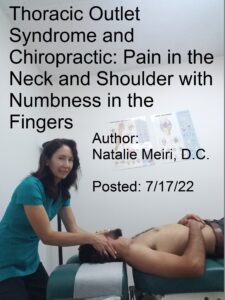
This post is about Thoracic Outlet Syndrome and Chiropractic: Pain in the Neck and Shoulder with Numbness in the Fingers. You may have diffuse (spread out) arm symptoms, including numbness and tingling. Often, you may describe the pain taking a path down the inside of your arm to the little and ring fingers. Moreover, when you do any overhead activity it is often made worse. For example, overhead throwing, serving a tennis ball, and painting a ceiling may exacerbate symptoms. Frequently, you may have weakness radiating from the neck and shoulder and extending into the arm and hand. Even driving and typing may sometimes be difficult.
If you have Thoracic Outlet Syndrome, Chiropractic can provide relief! We’ve got some great information to share below.
Compression at the Thoracic Outlet and Causes
The term “thoracic outlet” is the area between the neck and shoulder, over the top of the thorax (chest), and under the clavicle (collar bone). It is a space in the lower neck between the thorax and axilla (armpit) through which the subclavian vein, subclavian artery, and brachial plexus (network of nerves that provides movement and feeling to the shoulder, arm and hand) travel.
Compression at the thoracic outlet can involve the brachial plexus, subclavian artery, or subclavian vein at various sites as they travel downward into the arm. Several common sites are possible for compression.
Cervical Rib
Compression may occur at an elongated C7 transverse process (small bony projection off the right and left side of each vertebrae (interlocking bones that form the spinal column) also called a “cervical (neck) rib”. This is an abnormality only found in 1% of the population from birth. And among these 1%, only 10% of the individuals have symptoms. Similarly, a fibrous band connecting the cervical rib to the first rib also may be the culprit in some cases.
Scalene Triangle
Muscular compression can occur at the scalene (three paired muscles located in the lateral (side) aspect of the neck) muscles. This narrow vertical space formed between the two scalene muscles, with the first rib at the base, is called the scalene triangle. The major nerves and blood vessels supplying the upper extremity (limbs) lie within or next to the scalene triangle. Moreover, as they pass through the upper part of the thoracic outlet over the first rib, compression can happen. So the scalene muscles maybe hypertrophic (tight) causing compression.
Subcoracoid Space
The pectoralis minor is a small muscle that lies deep to the much larger pectoralis major muscle in the front of the upper chest. It arises from the upper ribs and runs upward to attach to a bony protrusion underneath the clavicle known as the coracoid process. Subsequently, the nerves and blood vessels pass underneath the pectoralis minor tendon through the subcoracoid space where compression may occur.
Costoclavicular Space
Compression can occur at the costoclavicular area. After passing over the first rib, the brachial plexus nerves, subclavian artery, and subclavian vein all pass together underneath the clavicle. Next, they cross underneath a small muscle that runs along the back of the clavicle, called the subclavius muscle. Additionally, this muscle attaches to the front part of the first rib, where it forms a band of dense connective tissue called the costoclavicular ligament. So the costcoclavicular space between the clavicle and first rib is another potential site for compression in thoracic outlet syndrome.




Thoracic Outlet Syndrome and Chiropractic: Pain in the Neck and Shoulder with Numbness in the Fingers
There are many causes of Thoracic Outlet Syndrome. Firstly, compression may be due to physical trauma such as from a car accident or a sports injury. Secondly, anatomical defects from birth may show symptoms later in life. Thirdly, tumors that press on nerves, though rare, are possible. Fourthly, the changes of pregnancy (e.g. postural, hormonal, swelling) may lead to Thoracic Outlet Syndrome. Lastly, poor posture such as a forward head carriage and rounded shoulders can lead to compression. And repetitive arm and shoulder movements and activity, such as from playing certain sports also are a potential culprit. These overuse injuries can lead to swelling and fibrosis causing compression of the nerves and vessels.
Nerve conduction studies or imaging (x-ray) studies to confirm or rule out a diagnosis of Thoracic Outlet Syndrome maybe recommended.
Treatment at Meiri Chiropractic of Thoracic Outlet Syndrome
Chiropractic manipulative treatment/therapy to the spine and extremities (e.g. limbs, ribs) are effective for thoracic outlet syndrome. Our other therapies, such as soft tissue techniques, electric muscle stimulation, ice/ heat therapies and homeopathic consultations provide relief. Indeed, postural correction, stretching of tightened muscles, and strengthening of weakened muscles is important in Thoracic Outlet Syndrome. This includes strengthening of the middle and lower trapezius and rhomboids, and stretching of the pectoralis and scalenes. Through regular chiropractic visits, you can get pain relief and improve your health without drugs or surgery!
At Meiri Chiropractic we spend the time necessary to examine, diagnose and treat every neuromusculoskeletal condition and various ailments you have. Chiropractic is a holistic and natural way to not only treat existing conditions, but to keep your body in its best working condition. We have been offering effective chiropractic care in Palm Beach county since 2006. Many of our patient reviews note our excellence. Call us today at 561-253-8984 to make an appointment or to find out more about Thoracic Outlet Syndrome and Chiropractic: Pain in the Neck and Shoulder with Numbness in the Fingers.